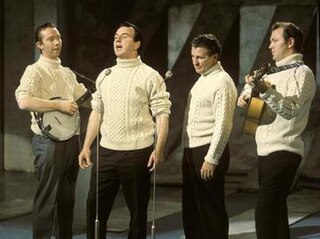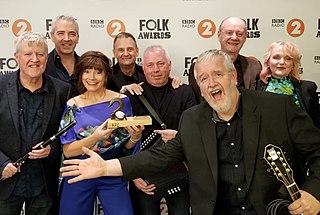Related Research Articles

Mary Rose-Anne Bolduc, born Travers, was a musician and singer of French Canadian music. She was known as Madame Bolduc or La Bolduc. During the peak of her popularity in the 1930s, she was known as the Queen of Canadian Folk Singers. Bolduc is often considered to be Quebec's first singer-songwriter. Her style combined the traditional folk music of Ireland and Quebec, usually in upbeat, comedic songs.

Irish music is music that has been created in various genres on the island of Ireland.

The Clancy Brothers were an influential Irish folk music group that developed initially as a part of the American folk music revival. Most popular during the 1960s, they were famed for their Aran jumpers and are widely credited with popularising Irish traditional music in the United States and revitalising it in Ireland, contributing to an Irish folk boom with groups like the Dubliners and the Wolfe Tones.
Mary Margaret O'Hara is a Canadian singer-songwriter, actress and composer. She is best known for the album Miss America, released in 1988. She released two albums and an EP under her own name, and remains active as a live performer, as a contributor to compilation albums and as a guest collaborator on other artists' albums.

Kathleen Alice Mattea is an American country music and bluegrass singer. Active since 1984 as a recording artist, she has charted more than 30 singles on the Billboard Hot Country Songs charts, including four that reached No. 1: "Goin' Gone", "Eighteen Wheels and a Dozen Roses", "Come from the Heart", and "Burnin' Old Memories", plus 12 more that charted within the top ten. She has released 14 studio albums, two Christmas albums, and one greatest hits album. Most of her material was recorded for Universal Music Group Nashville's Mercury Records Nashville 8division between 1984 and 2000, with later albums being issued on Narada Productions, her own Captain Potato label, and Sugar Hill Records. Among her albums, she has received five gold certifications and one platinum certification from the Recording Industry Association of America (RIAA). She has collaborated with Dolly Parton, Michael McDonald, Tim O'Brien, and her husband, Jon Vezner. Mattea is also a two-time Grammy Award winner: in 1990 for "Where've You Been", and in 1993 for her Christmas album Good News. Her style is defined by traditional country, bluegrass, folk, and Celtic music influences.

Frank Harte was a traditional Irish singer, song collector, architect and lecturer. He was born in Chapelizod, County Dublin, and raised in Dublin. His father, Peter Harte, who had moved from a farming background in Sligo, owned 'The Tap' pub in Chapelizod.

Muireann Nic Amhlaoibh is a musician and singer from County Kerry, Ireland. Until 2016, she was the lead singer for the traditional music group Danú, and from that year on she has been half of the electronica duo Aeons.
Carmel Gunning is an Irish composer and musician, from Sligo, Ireland. Gunning is one of Ireland's most accomplished tin whistle players who is also known for her singing and flute playing and also plays guitar and button accordion. Gunning's rich stylised form of whistle playing and tradition stems from her homeland of Geevagh in South County Sligo. This background and tradition aided Gunning's introduction to traditional Irish music which took place at an early age.
Lasairfhíona Ní Chonaola is an Irish singer-songwriter. She is deeply rooted in the sean-nós singing style of her home on Inis Oírr, one of the Aran Islands.
"The Maid and the Palmer" is an English language medieval murder ballad with supernatural/religious overtones. Because of its dark lyrics, the song was often avoided by folk singers. Considered by scholars to be a "debased" version of a work more completely known in European sources as the Ballad of the Magdalene, the ballad was believed lost in the oral tradition in the British Isles from the time of Sir Walter Scott, who noted a fragment of it having heard it sung in the early years of the nineteenth century, until it was discovered in the repertoire of a living Irish singer, John Reilly, from whom it was collected in the 1960s, although subsequently other versions have surfaced from Ireland from the 1950s to the 1970s; an additional full text, collected and notated in around 1818, was also recently published in Emily Lyle's 1994 Scottish Ballads under the title "The Maid of Coldingham", having remained in manuscript form in the intervening time. Based on a tape of Reilly's performance provided by the collector Tom Munnelly, the singer Christy Moore popularised the song under its alternate title "The Well Below the Valley" with the Irish folk band Planxty and later solo performances/recordings, this song providing the title of that group's second album released in 1973; the song has subsequently been recorded by a number of more recent "folk revival" acts.

Stanbrook Abbey is a Catholic contemplative Benedictine Monastery with the status of an abbey, located at Wass, North Yorkshire, England.
"Bonnie Annie" is a folk ballad recorded from the Scottish and English traditions. Scottish texts are often called Bonnie Annie or The Green Banks of Yarrow, English texts are most often called The Banks of Green Willow. Other titles include The Undutiful Daughter, The High Banks O Yarrow, The Watery Grave, Green Willow, There Was a Rich Merchant that Lived in Strathdinah and The Merchant's Daughter.
"Down by the Salley Gardens" is a poem by William Butler Yeats published in The Wanderings of Oisin and Other Poems in 1889.

Dervish is an Irish traditional music group from County Sligo, Ireland which has been described by BBC Radio 3 as "an icon of Irish music". They were formed in 1989 by Liam Kelly, Shane Mitchell, Martin McGinley, Brian McDonagh, and Michael Holmes and have been fronted by singer Cathy Jordan since 1991. They represented Ireland in the final of the Eurovision Song Contest 2007, singing a song written by John Waters and Tommy Moran. In 2019 they released an album on the US Rounder Records label called The Great Irish Song Book featuring a selection of classic Irish songs sung by a number of well known singers including Steve Earle, Andrea Corr, Vince Gill, Kate Rusby, Imelda May, Rhiannon Giddens, The Steel Drivers, Brendan Gleeson, Abigail Washburn, and Jamey Johnson. In 2019 they received a lifetime achievement award from the BBC.
Sylvia Woods is an American harpist and composer, and is perhaps best known for her role in the worldwide renaissance of the Celtic harp, or cláirseach. Woods began selling and writing music for Celtic harps in the 1970s, when the instrument was not widely known in the United States, contributing to a groundswell of interest in the Celtic harp and music. Woods was named one of the “most influential harp forces of the twentieth century” by HarpColumn magazine.

Irish traditional music is a genre of folk music that developed in Ireland.

Mary Ann Kennedy, is a Scottish musician, singer, choral director, composer, radio and television presenter, and music producer.
Flora MacNeil, MBE was a Scottish Gaelic Traditional singer. MacNeil gained prominence after meeting Alan Lomax and Hamish Henderson during the early 1950s, and continued to perform into her later years.
"Down by Blackwaterside" is a traditional folk song, provenance and author unknown, although it is likely to have originated near the River Blackwater, Northern Ireland. Peter Kennedy suggests that the lyrics originated in England, later picking up the best known tune in Ireland. Versions with a different tune have been collected in the English West Country. There is a Blackwater River in South East England.
Ollie Gilbert (1892–1980) was a folk musician from the Ozarks in Arkansas. She sometimes performed as "Auntie Ollie". Max Hunter recorded her singing more than 300 folk songs.
References
- ↑ "Ricorso: Digital materials for the study and appreciation of Anglo-Irish Literature". Ricorso.net.
- 1 2 3 "Catholic Weekly biodata on Mary O'Hara". Archived from the original on 12 June 2011.
- 1 2 "Eugene Register-Guard - Google News Archive Search". News.google.com.
- 1 2 3 [ permanent dead link ]
- 1 2 "Mary O'Hara's official website, ibid". Archived from the original on 28 August 2008.
- ↑ "Mary O'hara: Her Music, Her Life". Archived from the original on 1 February 2013.
- ↑ O'Hara's final vows at Stanbrook Abbey; news.google.com; accessed 14 March 2014.
- ↑ "Mary O'Hara: Her music, her life". Archived from the original on 31 January 2013.
- ↑ "Official Mary O'Hara website" (PDF). Maryohara.co.uk.
- 1 2 "Handmusic website". Archived from the original on 14 July 2009.
- ↑ O'Hara, Mary (4 February 1985). Celebration of Love: A Collection of Favourite Prose and Poetry. Hodder & Stoughton. ISBN 9780340373231 – via Google Books.
- ↑ "Mary O'Hara - Travels With My Harp". Maryohara-travelswithmyharp.co.uk.
- ↑ "Harp On The Willow | Ensemble Productions". Australianstage.com.au.
- ↑ Sims, John (30 October 2016). "Mary O'Hara - travels with my harp". Maryohara-travelswithmyharp.co.uk. Retrieved 20 January 2018.
Mary and her husband Padraig now live on the Aran Islands, off the west coast of Ireland
- ↑ "Aran-born missionary, teacher and devoted husband". The Irish Times. 21 November 2015. Retrieved 17 June 2019.
- ↑ Folk Harp Journal - Issues 24-27 1979 My admiration for Mary O'Hara has increased steadily since I first heard her singing and accompanying herself on the Irish Harp in the album, SONGS OF IRELAND, Tradition (JLP 1024), twenty years ago. "
- 1 2 Roberts, David (2006). British Hit Singles & Albums (19th ed.). London: Guinness World Records Limited. p. 405. ISBN 1-904994-10-5.